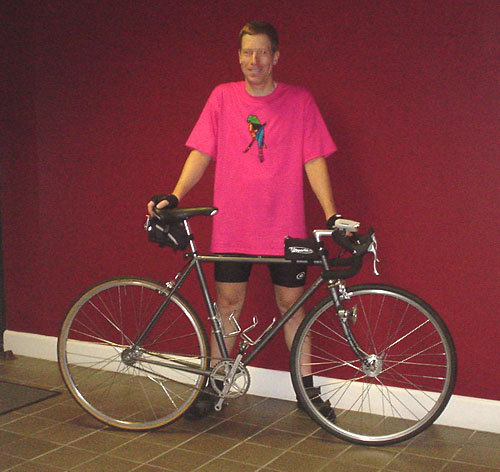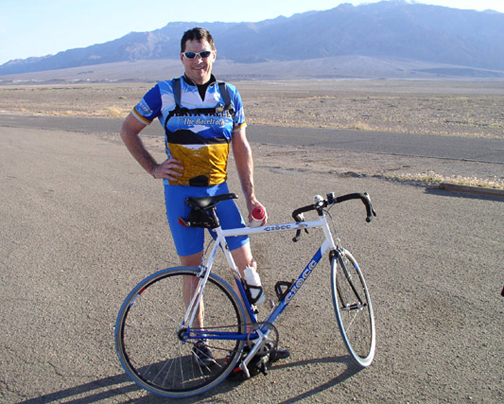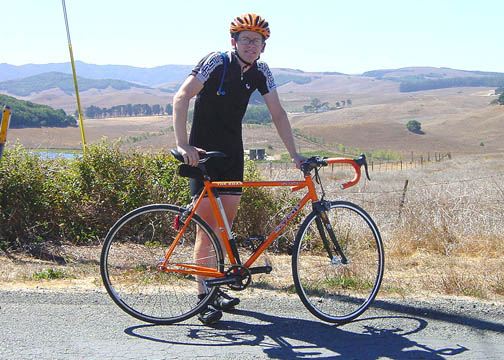Fixed Gear Cyclists Challenge World's Toughest Weekend Bicycle Race
Furnace Creek 508, a non-stop 508 mile bicycle race from Santa Clarita to Twenty Nine Palms via California's Death Valley and Mojave Desert, is the world's premiere weekend ultramarathon bicycle race. Produced by AdventureCOPRS since 1990, but founded in 1983 by John Marino, the October 16-18 2004 edition celebrates the 21st anniversary, and 30th edition, of this incredible race. New for 2004, three hardy endurance cyclists will challenge the brand new Fixed Gear Division at this world famous bicycle race. They'll tackle the entire event with just one gear and no coasting, as well as traditional steel frames, standard 32 spoke wheels, and no aero handlebars.
Furnace Creek 508 is revered the world over for its epic mountain climbs totalling over 30,000 feet of cumulative elevation gain, stark desert scenery, desolate roads, and a reputation as one of the toughest but most gratifying endurance challenges available, bar none. Known as "The Toughest 48 Hours in Sport," Furnace Creek 508 is "Where the West is Won!" The fixed gear racers in the 2004 race will be blazing their way into the history books at this venerable event. Here's a profile of each.
Jeff Parrot Bauer, 44, Nashville, TN, 508 Rookie
Fixed Gear Event Experience: Rocky Mountain 1200K, July 21-25th, 2004.
Type of Bike: I'm riding an old steel frame Trek of unknown vintage, passed from father to son then sold to me. I've replaced the wheels with Mavic Open Pro rims -- a Suzue track hub on the rear, Schmidt Dynohub generator on the front for nighttime riding. The crankset is whatever Campy gear that came with the bike. The outer chain ring was hacksawed off by the previous owner. I ride 42x17 gearing and use double-sided SPD pedals for ease of entry. Avocet Fasgrip 25C tires at under 100psi pressure provide a comfortable ride over long distances. Since adjusting the chain length with a half-link, the bike is virtually bomb-proof. When I remember to bring a 15mm wrench I can even change a rear flat.
Gear Inch: 42x17, which works out to 67-68 gear inches.

Are two identical gears really the same? (A bigger ring and bigger cog can be identical to a smaller cog and smaller ring in gear inches, but do they "feel" the same?): I don't know, because I've never tried larger rings. Sheldon Brown says no. There's a modest weight savings in using a smaller ring/cog combination, though I use it because I already had a 42 ring.
Types of rear dropouts used, as well as you how tension the chain: I'm using an old steel frame with horizontal dropouts. The eccentric hub is cool, but pricey. On one of my fixed-gear bikes -- the one I'm bringing to the Furnace Creek 508) -- I use a half-link (available from Harris Cyclery) to get the chain length correct. My preference is to use track nuts to secure the rear wheel, though it means I have to carry a 15mm wrench. Others use a quick release skewer with no problem.
Brakes: how many, why, what kind: All my fixed riding this year, including the Rocky Mountain 1200K, have been with a front brake only. It's all you really need for most riding. I've added a rear brake for the 508, however, because the long descents are tiring on just one hand. After the 508, I'll remove the rear brake.
Physical ailments and issues: Saddle interface is the number one issue for fixed rides over 200 miles. Knee pain can be caused by trying to spin too fast on flat sections when you're attempting to ride out of the saddle (to relieve saddle pressure). Heat exacerbates the problem.
Why ride fixed, especially really far? Because I've got a brain the size of a pea. Specifically for the 508, however, I thought it would be an interesting challenge. I'm not fast enough to be competitive in the geared divisions. Just finishing the ride on a fixed-gear within the 48 hour time limit is still a considerable challenge for someone who rides at my level.
What else do you find curious and enlightening? All the non-fixed riders assume that the climbs are the most difficult part of fixed-gear riding. This is true for steep grades (>10%), but the hard part is actually descents (if you're trying to spin fast), and worse of all: long flat sections where you're stuck in your chosen gear. I find headwinds, especially if they're variable, easier on a fixed, because I'm used to adapting my cadence rather than changing gears. For some reason a riding against a headwind on a fixed-gear isn't quite as demoralizing as on a gear bike.
Sam Seal Beal, 52, Mountain View, CA, 508 Veteran: 35:42:15 solo in 1999, 35:39:09 solo in 2000, and 35:14:40 solo in 2002
Fixed Gear Event Experience: Death Valley Double Century, Mar 6, 2004 (see photo above); Davis 24hr (252miles), April 11, 2004; Eastern Sierra Double Century, May 21 2004.
Epic Fixed Gear Rides of 100+ Miles: Solo, unsupported one way ride from Mtn View to Paso Robles on a 100 degree day - Aug 27 2004 (I begged water from ranchers and detoured to Bradley, where I was "saved" by the ice machine at the CDF). Plus a couple of 100+ nite rides around "the loop" on the San Francisco Peninsula.

Type of Bike: Ciocc EOM 12.5 2003 (Dedaccia steel tubing with carbon forks). Rear wheel is White Industries Eccentric ENO hub on Velocity Fusion rim; Front wheel is Ultegra/Fusion. Pedals are DuraAce; Cinelli bars; Newton stem; Campy Record brake levers; Dura cranks & calipers.
Gear Inch: My gear inches for the 508 (and all the riding I've done leading up to it) is ~73", using 42/15 or 40/14.
Are two identical gears really the same? (A bigger ring and bigger cog can be identical to a smaller cog and smaller ring in gear inches, but do they "feel" the same?): For "normal" gear ratios, I don't think you can tell the difference.
Types of rear dropouts used, as well as you how tension the chain: I have a 20yr old Merckx with horizontal dropouts and a new steel Ciocc with vertical dropouts. I use a White Industries eccentric ENO for the latter.
Brakes: how many, why, what kind: I have standard road bike brakes - front and rear.
Physical ailments? I think fixed is a little harder on your rear-end.
Why ride fixed, especially really far? Once you get past an initial "break in" period, fixed-gear is easier than it looks. Part of the "break-in" is remembering you are on a fixed-gear and cannot "jump" over a pothole or RR track like you can with a freewheel. Getting vaulted over the handle bars will "fix" your memory on that one.
What else do you find curious and enlightening? Compared to 18-speed bikes, what you lose by not being in a big enough gear on flats/descents, you make up for by not being in too small a gear when a larger one is better. This happens at nite when you think you're going fast because you are spinning, but you're spinning too small a gear. At least with fixed all you have to think about is your spinning.
Barley Boar Forsman, 33, San Rafael, CA, 508 Rookie
Fixed Gear Event Experience:
San Francisco 200K (1-31-2004)
Santa Rosa 200K (3-13-2004)
Davis 200K (3-6-2004)
Davis 300K (3-20-2004)
Santa Rosa 400K (5-8-2004)
Santa Rosa 600K (5-29-2004)
Davis Double Century (5-15-2004)
Marin Mt Tam Double Century (8-7-2004)

Type of Bike:
Frame: Custom Sycip road/track frame (www.sycip.com - best custom steel for the money!)
Frame details: Horizontal drop-outs (120mm), rear brake braze-on's, relaxed (classic Italian) geometry.
Wheels: Phil Wood hubs & spokes, laced to Mavic Open Pro rims (re-built hubs for QRs)
Fork: Carbon Easton SLX (pretty light!)
Handlebars, stem, seatpost: Easton carbon (aluminum stem)
Brakes: Zero Gravity (I haven't actually put these on yet - hope they work!)
Cranks: FSA compact carbon (fits the smaller rings)
Pedals: Dura Ace (nice wide platform - hope I don't have to walk!)
Seat: Fizik Gobi (a little soft, but feels good so far)
Tires: Continental GP3000 (you can't go wrong with these!)
Gear Inch: I have been experimenting with about every combination on the planet, but I have finally chosen a 42x15, or just over 74 gear inches. It's a big gear (and I may pay for that), but it's what I feel most comfortable on.
Are two identical gears really the same? (A bigger ring and bigger cog can be identical to a smaller cog and smaller ring in gear inches, but do they "feel" the same?):
This is one of those "big debate" type questions, but what the heck, I'll bite. I have been experimenting with this as well. I was using a 36x13 for quite a while (actually still have it on my bike!) as a way to keep a comparable gear, but shed a few grams. In theory it will be less weight, have less friction (less teeth to "run" through), and wear faster (less teeth to "run" through). I believe, in theory, that there should be no "real" difference in "feel" at the pedals, however, having said that, I have a preference based on "feel". I think the slightly larger front ring, and larger cog "feel" a little more smooth, and seem to maintain the momentum generated at the wheel much better. Again the difference is really very, very minor and there is an actual gear inch difference off by .8", but lacking the scientific data to back me up, that's just the way it feels.
Types of rear dropouts used, as well as you how tension the chain: My first fixie was a Bianchi Pista with 120mm spacing and true horizontal dropouts. I didn't like the angles of the bike and I couldn't mount full fenders (it was a winter training bike), and the "minor" problem of the chain popping off led me to sell that one with only 6 months of ownership! I bought a Surly cross bike (it has long vertical dropouts) and converted it over to a fixie - it is ideal in every way (except the weight!) I experimented with all different kinds track nuts and initially I thought it was "cool" to carry around a wrench, until I started getting flats - try changing a flat in the rain, riding home after work in the dark with a wrench and nuts (it sucks!) I know this is another controversial issue, but I switched over to a QR and I believe it is absolutely the way to go. I have never, ever had it slip out or come loose - keep in mind that I use steel Dura Ace QRs (some of the strongest around). I can adjust the chain tension in a snap, and changing a flat is almost the same as a geared bike. I will never go back to nuts, and I personally can't see any reason to use nuts. My current bike is a Sycip (possibly the best custom bike builder on the planet!!) with track, horizontal dropouts with 120mm spacing, and QRs. To adjust the chain, I'll pull the wheel back until it is tight and tighten the QR. Then I'll spin the wheel by hand until the chain is the most taught and make a second adjustment if necessary. At it's tightest point it should not slow the wheel (if it does, it's too tight!) There will always be some play in the chain, that's just the nature of the beast!
Brakes: how many, why, what kind: I'm a BIG believer in 2 brakes - there is no reason to have less than that! If you're just riding short distances with a really low gear inch than you can probably get away with a front brake and good control over pedal speed. On a long ride you don't want to have to place any extra stress on your muscles, joints, and ligaments - I almost always only pedal "forward". What I mean is that I almost never apply backward force to slow my bike, it's just too hard on your body (especially on a long descent). Because you use your brakes to control your down hill speed, they are essentially "drag" brakes, and if you have two, you can modulate between the front and the back brake to reduce rim heat. Having two brakes also splits the strength needed to stop to two hands instead of one - one hand will definitely get more tired over time than two. Use two brakes if functionality is your only concern, use one brake if track tradition and aesthetics are your only concern.
My Surly has standard cantilever style brakes and my Sycip has short reach road brakes - both seem to work fairly well, but actual stopping power doesn't need to be as great on a fixie (with a lower top-end speed), and especially with two brakes.
Physical ailments and issues: Nothing too bad, or totally debilitating, but I have been building up very gradually over the last year or so - I would never recommend for someone to go out and do a hilly ride on the first ride out, it will probably trash your knees (I believe that!) I'll definitely feel my knees on a really long, hard ride, but they seem to recover quickly - I've never had to stop riding because of pain. I have a re-occurring hip pain occasionally (in the ball and socket in my hip) and I think that is from over-use, but stretching has helped that quite a bit. The best advice I can give is: let the bike decide how you climb, if it's too hard to sit, stand up!! It's simple, but if you force yourself to push a slow cadence seated, it is likely you'll injure something!
Why ride fixed, especially really far? You have no idea how often I get this question: Why?? My answer changes all the time, but the general theme is the same: Because I can!! Why does anybody go with their local club on the weekends for a 30 - 40 mile ride? Why does anybody want to ride a century, and why would anybody ever consider riding 200 miles in one day? Because it's there, and because you can! The fixed gear is really no different, it's just a different challenge. Ultra distance is a slightly different thing - generally you're in a different class of "nut-cases" willing to subject themselves to days of pain and suffering. In this case, I am willing to admit that I might be a little "off", but then again, sanity is a relative thing, right? Why fixed? Why not fixed?
What else do you find curious and enlightening? Like most other fixie riders, I was first drawn to the simplicity of one, single, fixed gear. You have to grind to get up the hills and spin like a mad man to get down - no gears to get in the way. Trainers say that it is good for developing a good, smooth spin - which it does, but it can also give you a pretty good dead spot in your pedal stroke (no one ever talks about that!) When you get back on the "coastie" after a month off, it is very likely you'll feel, and hear a knock, or clunk in your pedal stroke - where you've gotten used to the wheel pulling the pedal around for you. You'll have to re-learn how to spin, and how to descend!
I guess what I've learned from riding the fixie is that in so many ways it's the same as riding any other bike, with the same set of challenges and rewards, but at the same time, the fixie is it's own breed of bicycle, and if you're not careful, it'll end up riding you! You can never forget that you're riding a fixie, and if you do, your fixie will be sure to remind you! The fixie is not passive and you must work with it to be successful - it can be a great team, but you have to be willing to listen to what your fixie has to say. The fixie has more "personality" than any bike I've ever ridden - it's like that brutally honest friend who isn't afraid to tell you you've put on a few pounds, and you really aren't climbing as fast as you used to. It'll tell you if you're spinning too fast, or not fast enough. It'll tell you that every climb is possible, if you want it bad enough! It'll tell you that you're not feeling as good as you thought - "better reconsider this ride!" But that honesty is also the greatest thing in the world when you finish a hard ride and you and your fixie know that you earned every inch of it - there was not one time that either you or your fixie didn't actively participate in the ride. One unit working together for a common goal.
To read the rules for this division and other information about fixed gear cycling, click here.
Furnace Creek 508 Sponsors: Special thanks to Hammer Nutrition, Injinji Anatomical Interface Systems (makers of the five toe "tsoks"), Hilton Garden Inn of Santa Clarita, and the Best Western Gardens Motel of Twenty Nine Palms for their support of this event.
|